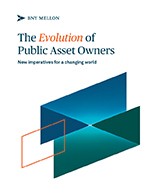Central Banks
Central banks’ core mission remains capital preservation and managing monetary policy, foreign exchange rates and debt. Therefore, safety and liquidity are primary concerns. However, an acutely low-yield environment makes it challenging for central banks to preserve capital and maintain reserves. Although central bank reserve portfolios are still primarily comprised of high-grade sovereign bonds issued in reserve currencies, as well as gold and cash deposits, many central bank interviewees say they face significant challenges sustaining their assets through traditional fixed-income portfolios. As a result, some central banks admit they have “taken a hit” to their reserves.
Diversification strategies are a key element in central banks’ response, as they look to a variety of asset classes that still put safety first. Some central banks have recently increased allocations to developed market sovereigns and agencies, and many have bought corporate bonds. Mortgage-backed securities and emerging market debt also offer opportunities. Outside fixed income, many central banks are either already investing in equities or exploring the asset class. The most advanced central banks in this space have active equities desks or employ external managers, while others tentatively consider equities via ETFs.
In making this shift, central bank interviewees described four strategies for tackling the challenges associated with diversification:
- Building asset class knowledge
- Tackling governance and administration
- Managing risk
- Adjusting portfolio approaches
Public Pension Funds
The prolonged low-yield environment has hit public pension funds hard. They have traditionally used a combination of member contributions and investment income from predictable fixed-income securities to pay pensions to their members. Recent trends, however, see public pension funds coming under pressure to diversify and extract the highest possible returns from equity positions and less liquid investments.
However, public pension funds must balance this shift with the need for sufficient cash flows to pay liabilities. Returns cannot compromise the ability to pay pensions when required. This requirement leads most public pension funds to deploy a strategic asset allocation (SAA) investment model. They base pools of funds on fixed allocations to specific asset classes over the medium term, even if a different allocation might mean greater returns. Pension risk transfer is another innovation in which a fund largely transfers its liabilities to others, such as selling them to insurance companies. The growth of pension risk transfer may be a structural shift or a temporary adaptation to the gains made by public pension funds in 2021.
Sourcing new opportunities is important for public pension funds to meet their obligations. But given the size of their assets yet less extensive in-house expertise, public pension funds must be creative in doing so – particularly in alternatives and private investments. One preferred tactic is co-investment, in which public pension funds combine forces with other investors and leverage their partners’ ability to identify targets and perform due diligence. For example, an interviewee at a mid-sized public pension fund said it was adopting a multi-pronged approach to diversify its alternatives exposure, including “customized portfolio solutions with bigger houses, co-investments, getting access to pre-IPOs and trying to find specific niches and pockets to capture opportunistic alpha.”
Sovereign Wealth Funds
Sovereign wealth funds (SWFs) have traditionally pursued returns as their primary objective, often with a goal of beating inflation by a specific measure. They have typically operated with a long-term investment horizon, a greater risk appetite than other public asset owners and expansive investment guidelines to achieve these goals. Such factors have enabled SWFs to invest in a wide range of asset classes and strategies.
In private markets, the key yield-related challenge for SWFs is access to attractive investments given increasing competition and skyrocketing valuations. In public markets, their steepest challenge is investing in equities at scale, given their potential to move the market, the availability of shares and the visibility of any significant investment to the wider market. Some of the largest SWFs have begun embracing complex investment practices from the private sector.
Unlike their other public asset owner counterparts, many SWFs look to a total portfolio approach focused on a core portfolio with a secondary alpha-driven portfolio for outsized returns. The core portfolio functions as the mainstay public markets portfolio, while the alpha portfolio, which competes for capital with the core, is often biased toward private markets and credit strategies.
The competition for capital ensures a disciplined and rigorous approach to capital allocation and makes the process more dynamic than the more rigid SAA approach. It also has governance implications. With a total portfolio approach, the investment team under the direction of the CIO makes decisions more dynamically, without directly engaging the board. The team bases decisions on risk factors rather than benchmark weights, bringing together disparate investment professionals into one team, as risk rather than asset class is the primary consideration.
In addition, SWFs employing a total portfolio approach require a dynamic monitoring process to ensure that investment strategies and dynamic rebalancing are consistent with an SWF’s investment policy statement. Their middle- and back-office data capabilities must be robust enough to support this oversight.







